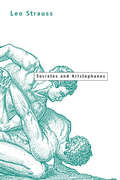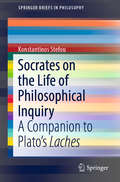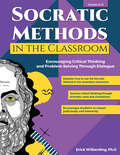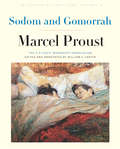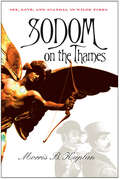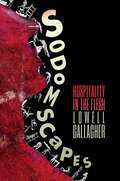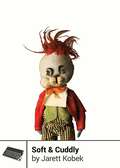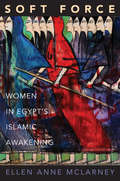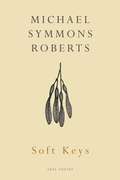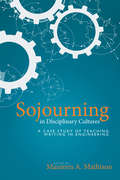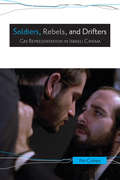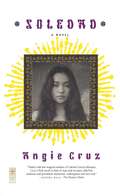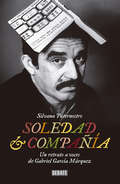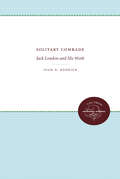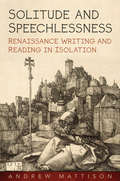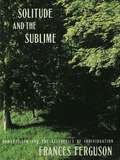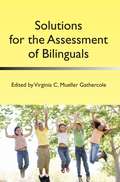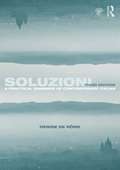- Table View
- List View
Socrates and Aristophanes
by Leo StraussIn one of his last books, Socrates and Aristophanes, Leo Strauss's examines the confrontation between Socrates and Aristophanes in Aristophanes' comedies. Looking at eleven plays, Strauss shows that this confrontation is essentially one between poetry and philosophy, and that poetry emerges as an autonomous wisdom capable of rivaling philosophy. "Strauss gives us an impressive addition to his life's work--the recovery of the Great Tradition in political philosophy. The problem the book proposes centers formally upon Socrates. As is typical of Strauss, he raises profound issues with great courage. . . . [He addresses] a problem that has been inherent in Western life ever since [Socrates'] execution: the tension between reason and religion. . . . Thus, we come to Aristophanes, the great comic poet, and his attack on Socrates in the play The Clouds. . . [Strauss] translates it into the basic problem of the relation between poetry and philosophy, and resolves this by an analysis of the function of comedy in the life of the city. " --Stanley Parry, National Review
Socrates on the Life of Philosophical Inquiry: A Companion to Plato’s Laches (SpringerBriefs in Philosophy)
by Konstantinos StefouThis book offers the first systematic reading of Plato’s Laches in English after three decades of scholarly silence. It rekindles interest in this much-neglected dialogue by providing a fresh discussion of the major issues that arise from the text. Among these issues, pride of place is taken by the virtue of courage, for the definition of which Socrates is depicted as engaging in some long-winded dialectical exchange with his interlocutors. Yet, although there is no room for doubt that the Laches is Plato’s most explicit treatment of courage, this dialogue ends in perplexity and is thus traditionally thought of as an unsuccessful attempt to define what courage is. The present study challenges this suggestion. This book proposes a new paradigm for the interpretation of Plato’s Laches. In fact, it constitutes the first systematic attempt to study the dialogue in light of the idea that its composition could well have formed part of Plato’s overall plan to establish a well-defined and rigorous justification of the life of philosophical inquiry The book will be of key interest to classicists, philosophers, and intellectual historians, but will also appeal to students or anyone interested in ancient Greek philosophy.
Socratic Methods in the Classroom: Encouraging Critical Thinking and Problem Solving Through Dialogue
by Erick WilberdingSince the Renaissance, the Socratic Method has been adapted to teach diverse subjects, including medicine, law, and mathematics. Each discipline selects elements and emphases from the Socratic Method that are appropriate to teaching individuals or groups how to reason judiciously within that subject. By looking at some of the great practitioners of Socratic questioning in the past, "Socratic Methods in the Classroom" explains how teachers may use questioning, reasoning, and dialogue to encourage critical thinking, problem solving, and independent learning in the secondary classroom. Through a variety of problems, cases, and simulations, teachers will guide students through different variations of the Socratic Method, from question prompts to the case method. Students will learn to reason judiciously, gain an understanding of important issues, and develop the necessary skills to discuss these issues in their communities.
Sodom and Gomorrah: In Search of Lost Time, Volume 4
by Marcel ProustAn authoritative new edition of the fourth volume in Marcel Proust's epic masterwork, In Search of Lost Time series Marcel Proust’s monumental seven-part novel In Search of Lost Time is considered by many to be the greatest novel of the twentieth century. The fourth volume, Sodom and Gomorrah, is notable for its pioneering discussion of homosexuality. After its publication, Colette wrote to Proust, “No one has written pages such as these on homosexuals, no one!” This edition is edited and annotated by noted Proust scholar William C. Carter, who endeavors to bring the classic C. K. Scott Moncrieff translation closer to the spirit and style of the original.
Sodom on the Thames
by Morris B. KaplanSodom on the Thames looks closely at three episodes involving sex between men in late-nineteenth-century England. Morris Kaplan draws on extensive research into court records, contemporary newspaper accounts, personal correspondence and diaries, even a pornographic novel. He focuses on two notorious scandals and one quieter incident. In 1871, transvestites "Stella" (Ernest Boulton) and "Fanny" (Frederick Park), who had paraded around London's West End followed by enthusiastic admirers, were tried for conspiracy to commit sodomy. In 1889–1890, the "Cleveland Street affair" revealed that telegraph delivery boys had been moonlighting as prostitutes for prominent gentlemen, one of whom fled abroad. In 1871, Eton schoolmaster William Johnson resigned in disgrace, generating shockwaves among the young men in his circle whose romantic attachments lasted throughout their lives. Kaplan shows how profoundly these scandals influenced the trials of Oscar Wilde in 1895 and contributed to growing anxiety about male friendships. Sodom on the Thames reconstructs these incidents in rich detail and gives a voice to the diverse people involved. It deepens our understanding of late Victorian attitudes toward urban culture, masculinity, and male homoeroticism. Kaplan also explores the implications of such historical narratives for the contemporary politics of sexuality.
Sodoma: Poder y escándalo en el Vaticano
by Frédéric MartelSodoma expone la decadencia y la corrupción en el corazón del Vaticano y de la actual Iglesia católica. Es un libro con un claro mensaje al Vaticano de parte de todos los que anhelan una Iglesia inspirada en el Evangelio, una Iglesia para los pobres, los marginados y los desposeídos. Este brillante y perturbador trabajo, basado en cinco años de investigación rigurosa, incluye extensas entrevistas a los más altos cargos que ostentan el poder en el Vaticano.El libro revela la existencia de una camarilla gay en el Vaticano, en la que Frédéric Martel argumenta que sus orígenes vienen del papado de Pablo VI (1963 – 1978). Martel describe al Vaticano como «el mayor armario de la ciudad» y da pruebas de que un alto número de cardenales son homosexuales. Aun cuando estos mismos cardenales están entre la gente proponiendo decretos en contra del matrimonio homosexual y muchos otros temas relacionados con la moralidad sexual.Pero este libro también habla sobre corrupción en otras esferas del clero: el choque entre oficiales de la iglesia con regímenes fascistas que persiguen y torturan a gente inocente; turbios negocios inmobiliarios; la hipocresía al defender y proteger a curas pederastas; y, por encima de todo, la predominante cultura del clericalismo, a través del cual muchos escándalos son ignorados y dejados de lado. La crítica ha dicho...«La originalidad de su investigación es que establece la homosexualidad — una homosexualidad callada y mezclada de homofobia— como núcleo del sistema eclesiástico. [...] Es la llave que permite entender muchos de sus problemas.»El País «Un colosal ensayo fruto de cuatro años de investigación que revela la presencia mayoritaria de homosexuales en el clero, la jerarquía de la Iglesiacatólica y, sobre todo, en el Vaticano, hasta el punto de estructurar esa institución y de definirla.»El Mundo «Una bomba periodística que promete sacudir los cimientos de la Iglesia Católica y a la gran mayoría de sus representantes.»El Confidencial «Lo que era meramente anecdóticoadquiere por fin una visibilidad sociológica. Ya era hora.»Artículo de James Alison, uno de los sacerdotes entrevistados por Martel, en Jot Down «Cambiar la estructura es, honestamente, muy complejo. El papa no tiene realmente la capacidad para hacerlo solo.»Entrevista a Frédéric Martel a elDiario.es a través de EFE«No tengan miedo a su extensión porque estas páginas valen mucho la pena.»JNSP «Sexo, secretos y mentiras en el armario del Vaticano.»The Times «En Sodoma, Frédéric Martel describe un verdadero "sistema gay" en las altas esferas de la Iglesia. Su investigación será un hito.»Le Point
Sodomscapes: Hospitality in the Flesh
by Lowell GallagherSodomscapes presents a fresh approach to the story of Lot’s wife, as it’s been read across cultures and generations. In the process, it reinterprets foundational concepts of ethics, representation, and the body. While the sudden mutation of Lot’s wife in the flight from Sodom is often read to confirm our antiscopic bias, a rival tradition emphasizes the counterintuitive optics required to nurture sustainable habitations for life in view of its unforeseeable contingency.Whether in medieval exegesis, Russian avant-garde art, Renaissance painting, or today’s Dead Sea health care tourism industry, the repeated desire to reclaim Lot’s wife turns the cautionary emblem of the mutating woman into a figural laboratory for testing the ethical bounds of hospitality. Sodomscape—the book’s name for this gesture—revisits touchstone moments in the history of figural thinking and places them in conversation with key thinkers of hospitality. The book’s cumulative perspective identifies Lot’s wife as the resilient figure of vigilant dwelling, whose in-betweenness discloses counterintuitive ways of understanding what counts as a life amid divergent claims of being-with and being-for.
Soft & Cuddly (Boss Fight Books)
by Jarett KobekA computer game so nauseatingly gory that it came with a barf bag. Bright druggy graphics that sickened scores of proper English parents. Gameplay so violent that it inspired one of Britain's most infamous killing sprees. Soft & Cuddly, released for the ZX Spectrum in 1987, wasn't quite any of these things. But in an age of manufactured moral panics, John George Jones's fluorescent punk manifesto sure pissed off a lot of people. Featuring new interviews with the game's creator, Jarett Kobek's book dives deep into the gritty world of British yellow journalism, snarky computer fanzines, DIY home programming, and Soviet bootleg mixtapes. If Margaret Thatcher's Conservative Party was right that video nasties like Soft & Cuddly were the epitome of 80s depravity, then this book is headed straight to Hell.
Soft CLIL and English Language Teaching: Understanding Japanese Policy, Practice and Implications (Routledge Series in Language and Content Integrated Teaching & Plurilingual Education)
by Makoto Ikeda Richard Pinner Matthew Davis Yoshinori Watanabe Shinichi IzumiContent and Language Integrated Learning (CLIL) is a transformative and powerful approach to language education and has had a significant impact on educational pedagogy in recent years. Despite burgeoning literature on the efficacy and implementation of CLIL, there remains a gap between CLIL and English Language Teaching (ELT). Many practitioners wonder how they can ‘do CLIL’ if their main classes are focused on English as a Foreign Language (EFL). This volume addresses these concerns by examining the experiences of various CLIL practitioners in the EFL context of Japan. Chapters outline the CLIL methodology, the differences in ‘hard CLIL’ (subject led) and ‘soft CLIL’ (language-oriented) before focusing on the EFL interpretations of soft-CLIL. Although the distinction of hard CLIL and soft CLIL has been mentioned in several publications, this is the first book-length exploration of this issue, featuring chapters examining expectations, challenges, material support, implementation, and even motivation in CLIL classrooms. All of this culminates in a review of the potential and future of CLIL in EFL contexts, paving the way for more widespread and well informed implementation of CLIL all over the world.
Soft Force: Women in Egypt's Islamic Awakening
by Ellen Anne MclarneyIn the decades leading up to the Arab Spring in 2011, when Hosni Mubarak's authoritarian regime was swept from power in Egypt, Muslim women took a leading role in developing a robust Islamist presence in the country's public sphere. Soft Force examines the writings and activism of these women--including scholars, preachers, journalists, critics, actors, and public intellectuals--who envisioned an Islamic awakening in which women's rights and the family, equality, and emancipation were at the center.Challenging Western conceptions of Muslim women as being oppressed by Islam, Ellen McLarney shows how women used "soft force"--a women's jihad characterized by nonviolent protest--to oppose secular dictatorship and articulate a public sphere that was both Islamic and democratic. McLarney draws on memoirs, political essays, sermons, newspaper articles, and other writings to explore how these women imagined the home and the family as sites of the free practice of religion in a climate where Islamists were under siege by the secular state. While they seem to reinforce women's traditional roles in a male-dominated society, these Islamist writers also reoriented Islamist politics in domains coded as feminine, putting women at the very forefront in imagining an Islamic polity.Bold and insightful, Soft Force transforms our understanding of women's rights, women's liberation, and women's equality in Egypt's Islamic revival.
Soft Keys
by Michael Symmons RobertsWhen Corpus won the Whitbread Poetry Award, the judges described it as 'an outstanding, perfectly weighted collection that inspires meditation on the nature of the soul...reading it feels like making an exciting discovery and coming back to an acknowledged classic all at once.' Michael Symmons Roberts' first book, Soft Keys, was the original and most exciting discovery of all. The poems in Soft Keys engage in a search for meaning and order in the everyday and in the extraordinary - a locust officer tracking swarms in an African desert, a hobbyist building a replica of the world out of matchsticks, a chance encounter with the French mystic Simone Weil playing video games in a Torquay arcade... Richly inventive, and written in a wide diversity of poetic forms, Soft Keys looks for those places and moments where the curtain between earth and heaven is thinnest; it was a powerful, arresting debut and the beginning of a remarkable career. As Les Murray said at the time: 'Like Nijinsky, he can leap into the air and stay there. You can reach up and feel the thump of the stage finely persisting in an ankle bone. Roberts is a poet for the new, chastened, unenforcing age of faith that has just dawned.'
Soft Skills for the New Journalist: Cultivating the Inner Resources You Need to Succeed
by Colleen SteffenJournalism is a pool staffed by distracted lifeguards and no matter how fancy your school is, your first week in a real newsroom will feel like a shove in the small of the back into 15 feet of water. Most of us come up for air eventually, but if you’re like journalist and educator Colleen Steffen, you may still be left feeling like all that training in inverted pyramids and question lists left something important out: you! Journalism is people managing, wrestling truth and story out of the messy, confusing raw material that is a human being, and the messiest human involved can often be the reporter themselves. So it’s time to talk about it. Instead of nervously skirting the sizable EQ (emotional intelligence) portion of this IQ (intelligence intelligence) enterprise, Soft Skills for the New Journalist explores how it FEELS to do this strange, hard, amazing job—and how to use those feelings to better your work and yourself.
Software Evangelism and the Rhetoric of Morality: Coding Justice in a Digital Democracy (Routledge Studies in Rhetoric and Communication)
by Jennifer Helene MaherExamining the layers of meaning encoded in software and the rhetoric surrounding it, this book offers a much-needed perspective on the intersections between software, morality, and politics. In software development culture, evangelism typically denotes a rhetorical practice that aims to convert software developers, as well as non-technical lay users, from one platform to another (e.g., from the operating system Microsoft Windows to Linux). This book argues that software evangelism, like its religious counterpart, must also be understood as constructing moral and political values that extend well beyond the boundaries of the development culture. Unlike previous studies that locate such values in the effects of code in-use or in certain types of code like free and open source (FOSS) software, Maher argues that all code is meaningful beyond its technical, executable functions. To facilitate this analysis, this study builds a theory of evangelism and illustrates this theory at work in the proprietary software industry and FOSS communities. As an example of political liberalism at work at the level of code, these evangelical rhetorics of software construct competing conceptions of what is good that fall within a shared belief in what is just. Maher illustrates how these beliefs in goodness and justice do not always execute in replicable ways, as the different ways of decoding software evangelisms in the contexts of Brazil and China reveal. Demonstrating how software evangelisms exert a transformative force on the world, one comparable in significance to code itself, this book highlights the importance of rhetoric in even the most seemingly a-rhetorical of technical endeavors and foregrounds the crucial need for rhetorical literacy in the digital age.
Sojourning in Disciplinary Cultures: A Case Study of Teaching Writing in Engineering
by Doug Downs Sarah Read Sarah A. Bell Linn K. Bekins Mara K. Berkland April A. Kedrowicz Julie L. Taylor Sundy WatanabeSojourning in Disciplinary Cultures describes a multiyear project to develop a writing curriculum within the College of Engineering that satisfied the cultural needs of both compositionists and engineers at a large R1 university. Employing intercultural communication theory and an approach to interdisciplinary collaboration that involved all parties, cross-disciplinary colleagues were able to develop useful descriptions of the process of integrating writing with engineering; overcoming conflicts and misunderstandings about the nature of writing, gender bias, hard science versus soft science tensions; and many other challenges. This volume represents the collective experiences and insights of writing consultants involved in the large-scale curriculum reform of the entire College of Engineering; they collaborated closely with faculty members of the various departments and taught writing to engineering students in engineering classrooms. Collaborators developed syllabi that incorporated writing into their courses in meaningful ways, designed lessons to teach various aspects of writing, created assignments that integrated engineering and writing theory and concepts, and worked one-on-one with students to provide revision feedback. Though interactions were sometimes tense, the two groups––writing and engineering––developed a “third culture” that generally placed students at the center of learning. Sojourning in Disciplinary Cultures provides a guide to successful collaborations with STEM faculty that will be of interest to WPAs, instructors, and a range of both composition scholars and practitioners seeking to understand more about the role of writing and communication in STEM disciplines. Contributors: Linn K. Bekins, Sarah A. Bell, Mara K. Berkland, Doug Downs, April A. Kedrowicz, Sarah Read, Julie L. Taylor, Sundy Watanabe
Soldier's Heart: Reading Literature Through Peace and War at West Point
by Elizabeth D. SametElizabeth D. Samet and her students learned to romanticize the army "through the stories of their fathers and from the movies." For Samet, it was the old World War II movies she used to watch on TV, while her students grew up on Braveheart and Saving Private Ryan. Unlike their teacher, however, these students, cadets at the United States Military Academy at West Point, have decided to turn make-believe into real life. West Point is a world away from Yale, where Samet attended graduate school and where nothing sufficiently prepared her for teaching literature to young men and women training to fight a war. Intimate and poignant, Soldier's Heart chronicles the various tensions inherent in that life as well as the ways in which war has transformed Samet's relationship to literature. Fighting in Iraq, Samet's former students share what books and movies mean to them-the poetry of Wallace Stevens, the fiction of Virginia Woolf and M. Coetzee, the epics of Homer, or the films of Bogart and Cagney. Their letters in turn prompt Samet to wonder exactly what she owes to cadets in the classroom. Samet arrived at West Point before September 11, 2001, and has seen the academy change dramatically. In Soldier's Heart, she reads this transformation through her own experiences and those of her students. Forcefully examining what it means to be teaching literature at a military academy, the role of women in the army, the tides of religious and political zeal roiling the country, the uses of the call to patriotism, and the cult of sacrifice she believes is currently paralyzing national debate. Ultimately, Samet offers an honest and original reflection on the relationship between art and life.
Soldiers, Rebels, and Drifters: Gay Representation in Israeli Cinema
by Nir CohenA cultural history of gay filmmaking in Israel that explores its role in the rise of gay consciousness over the past three decades.
Soledad
by Angie CruzAward-winning author Angie Cruz takes readers on a journey as one young woman must confront not only her own past of growing up in Washington Heights, but also her mother's. At eighteen, Soledad couldn't get away fast enough from her contentious family with their endless tragedies and petty fights. Two years later, she's an art student at Cooper Union with a gallery job and a hip East Village walk-up. But when Tía Gorda calls with the news that Soledad's mother has lapsed into an emotional coma, she insists that Soledad's return is the only cure. Fighting the memories of open hydrants, leering men, and slick-skinned teen girls with raunchy mouths and snapping gum, Soledad moves home to West 164th Street. As she tries to tame her cousin Flaca's raucous behavior and to resist falling for Richie—a soulful, intense man from the neighborhood—she also faces the greatest challenge of her life: confronting the ghosts from her mother's past and salvaging their damaged relationship. Evocative and wise, Soledad is a wondrous story of culture and chaos, family and integrity, myth and mysticism, from a Latina literary light.
Soledad y compañía
by Silvana PaternostroEste libro es un boleto de entrada para una fiesta en la que todos hablan, todos gritan, todos opinan, se contradicen y hasta dicen mentiras.Bienvenidos. Soledad & Compañía es un retrato humano, fresco e irreverente de Gabriel García Márquez donde se entretejen las voces de sus amigos, sus seres queridos y hasta sus detractores, quienes nunca antes habían compartido sus historias con el premio Nobel. Habla su mítica agente Carmen Balcells, su traductor al inglés, la española a quien dedicó Cien años de soledad, y hasta el escritor norteamericano William Styron, entre otros. Lo que se va desvelando es la biografía de Gabo desde los tiempos desordenados y esperanzadores en que un muchacho de provincia se propuso ser escritor hasta convertirse en uno de los autores más universalmente leídos y admirados."Entre conversación y conversación, Silvana Paternostro, humaniza al escritor colombiano... retrata una vida que fue "fascinante de principio a fin"".Agencia efe"Esta magnífica investigación aporta una perspectiva inédita, diferente y reveladora."El Huffington Post
Solid Objects: Modernism and the Test of Production
by Douglas MaoIn this provocative and wide-ranging study, Douglas Mao argues that a profound tension between veneration of human production and anxiety about production's dangers lay at the heart of literary modernism. Focusing on the work of Virginia Woolf, Wyndham Lewis, Ezra Pound, and Wallace Stevens, Mao shows that modernists were captivated by physical objects, which, regarded as objects, seemed to partake of a utopian serenity beyond the reach of human ideological conflicts. Under a variety of historical pressures, Mao observes, these writers came to revere the making of such things, and especially the crafting of the work of art, as the surest guarantee of meaning for an individual life. Yet they also found troubling contradictions here, since any kind of making, be it handicraft or mass production, could also be understood as a violation of the nonhuman world by an increasingly predatory and imperialistic subjectivity. If modernists began by embracing production as a test of meaning, then they frequently ended by testing production itself and finding it wanting.To make this case, Mao interweaves social and political history with readings in literature, the visual arts, philosophy, and economics. He explores modernism's relation to aestheticism, existentialism, and the culture of consumption, joining current debates on the politics of engagement and the social meanings of art. And he shows conclusively, in this elegantly written and consistently surprising work, that we cannot understand the theories and practices of modernism without addressing the question of the object and production's ambivalent allure.
Solitary Comrade: Jack London and His Work
by Joan D. HedrickHedrick examines London's inner life, primarily as it is revealed in his art, to discover the man concealed beneath the public persona. Although London was wealthy, famous, and one of the last great self-made men in America, Hedrick shows that he was always torn by his troubled relationship to his lower-class origins. He lived in painful awareness of the contradictions between the man's world of the lower classes--at the workplace, on the road, and in prison--and the woman's world of the middle class in which he took refuge.Originally published 1982. A UNC Press Enduring Edition -- UNC Press Enduring Editions use the latest in digital technology to make available again books from our distinguished backlist that were previously out of print. These editions are published unaltered from the original, and are presented in affordable paperback formats, bringing readers both historical and cultural value.
Solitude and Speechlessness: Renaissance Writing and Reading in Isolation
by Andrew MattisonRecent literary criticism, along with academic culture at large, has stressed collaboration as essential to textual creation and sociability as a literary and academic virtue. Solitude and Speechlessness proposes an alternative understanding of writing with a complementary mode of reading: literary engagement, it suggests, is the meeting of strangers, each in a state of isolation. The Renaissance authors discussed in this study did not necessarily work alone or without collaborators, but they were uncertain who would read their writings and whether those readers would understand them. These concerns are represented in their work through tropes, images, and characterizations of isolation. The figure of the isolated, misunderstood, or misjudged poet is a preoccupation that relies on imagining the lives of wandering and complaining youths, eloquent melancholics, exemplary hermits, homeless orphans, and retiring stoics; such figures acknowledge the isolation in literary experience. As a response to this isolation of literary connection, Solitude and Speechlessness proposes an interpretive mode it defines as strange reading: a reading that merges comprehension with indeterminacy and the imaginative work of interpretation with the recognition of historical difference.
Solitude and the Sublime: The Romantic Aesthetics of Individuation
by Frances FergusonAs interest in aesthetic experience evolved in the eighteenth century, discussions of the sublime located two opposed accounts of its place and use. Ferguson traces these two positions - the Burkean empiricist account and the Kantian formalist one - to argue that they had significance of aesthetics, including recent deconstructive and New Historicist criticism.
Sollie, the Timid Puppy (Primary Phonics #Set 6 Book 4)
by Joan Fleiss Kaplan"These appealing decodable stories nurture early literacy development, which translates into building new readers' self-confidence. This, in turn, quickens the pace at which genuine reading comprehension is achieved ..."--Epsbooks.com.
Solutions for the Assessment of Bilinguals
by Virginia C. GathercoleSolutions for the Assessment of Bilinguals presents innovative solutions for the evaluation of language abilities and proficiency in multilingual speakers - and by extension, the evaluation of their cognitive and academic abilities. This volume brings together researchers working in a variety of bilingual settings to discuss critical matters central to the assessment of bilingual children and adults. The studies include typically developing bilingual children, bilingual children who may be at risk for language impairments, bilingual and multilingual children and adults found in classrooms, and second-language learners in childhood and adulthood. The contributions propose a variety of ways of assessing performance and abilities in the face of the multiple issues that complicate the best interpretation of test performance.
Soluzioni: A Practical Grammar of Contemporary Italian
by Denise De RomeSoluzioni: A Practical Grammar of Contemporary Italian comprises an engaging reference grammar with related exercises in one volume. Using an appealing visual layout, Soluzioni explains the main topics of modern Italian grammar in clear and concise language. Real language examples and plenty of varied and imaginative exercises show how grammar works in practice. No prior knowledge of linguistic terminology is required. Features include: Tables and charts for easy navigation and at-a-glance comprehension Authentic material from Italian media and literature showing grammar in context Graded practice exercises with answers so learners can review their progress A comprehensive index at the back of the book Particular attention to areas of difficulty, with special sections in each chapters dedicated to clarifying problematic grammar points A free companion website at? www.routledge.com/cw/rome offering a generous assortment of supplementary materials, including helpful appendices on spelling, pronunciation and Italian verbs, a glossary of grammatical terms, a full answer key to exercises, free interactive exercises and website links. This new and third edition has been fully revised and updated throughout and continues the accessible methodology and focus on contemporary usage that has made Soluzioni the clearest and most comprehensive pedagogical grammar available on the market today. More attention has been paid to the link between grammar and communicative functions, and those between grammar, context and register, and there has been expanded coverage of key areas of difficulty such as tense usage, the subjunctive, word order, causative verbs and verbs of perception. In addition, there are many new exercises. The companion website has also been revised to offer more resources for both students and instructors. Suitable for class use and independent study, Soluzioni is the ideal grammar reference and practice resource for all learners of Italian, from beginners to advanced students. It is particularly suitable for fast track use in ab-initio courses at university and at colleges.
